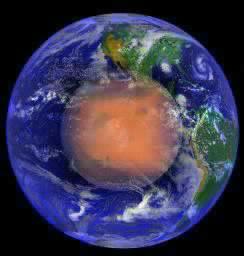
Cydonia Quest C D&M Pyramid - Examining the "Girders" C Part Two C
This page contains some very large images. Readers are advised to view this page in "full screen" mode to fit more of each image onto the screen at the same time. Press the F11 key to enter "full screen" and then F11 again to return to the normal browser view.
Some readers will also benefit by increasing their browser "zoom" by an increment - hold down the control key (Ctrl) and press the plus key (+). To return to standard zoom hold down the control key and press the minus key (-). For tips about adjusting the appearance of your browser display click here.
Viewing the images in low lighting conditions also makes details easier to see.
C The south-east facet
Although there are areas of interesting anomalies next to the D&M Pyramid the image analysis in the following pages will limit itself to the actual surface of the pyramid.
As the image poster below shows, much of the lower surface of the south-east facet of the pyramid is intensely honeycombed - as is the facet's ridgeline. However, a major slope collapse has eaten deeply into most of this facet. This has presumably destroyed or buried any evidence for artificiality in the affected areas.
The following satellite image of a Birmingham suburb has been scaled to approximately the same resolution as the final image in the poster above. It can be seen that the pits in the honeycombing are quite large in comparison to houses and road vehicles. This full resolution image only covers a tiny part of the D&M Pyramid. It makes plain just how colossal an arcology the pyramid would be.
Although it looks smooth, the area of the south-east facet between its lower levels and the ridgeline is equally as honeycombed. It is just that the honeycomb of pits has been covered by eroded material flowing from higher up the slope, and then also packed with windblown dust. However, careful examination of this slope at higher resolution reveals many isolated pits and shallow dimples where pits have been partially filled in. Some of this "hidden" honeycombing can be discerned in the previous poster images.
The most probable reason why the lower level honeycomb is so well defined is that vortices created by winds deflected down the slope blow dust out of the honeycomb pits nearer the bottom.
The nearest geological look-alike to this honeycombing is an erosional phenomena known as tafoni. The following image poster shows some examples. Tafoni surfaces are most commonly found on granular rock such as sandstone, granite and limestone. They are most commonly found in deserts and rocky shorelines. There are at least three explanations for how the lattice-like tafoni surfaces are formed (see µµµ). As the images in the poster illustrate, tafoni surfaces often look less like an erosional feature and more like a weird rocky growth spreading over the rocks.
One thing that is noticeable about tafoni surfaces is that the most intricate and dense lattice patterns only occur when the erosional hollows are small. In the previous image poster the last two images show how crude and sparse tafoni patterns are when the hollows are large. There is definitely an upper limit to how big the tafoni hollows can be and how intensive the tafoni pattern can remain. There is a trade-off between the two.
The honeycombing in the D&M Pyramid is intricate, intensive and extensive - yet the hollows are at least as big as houses. This is one reason they are unlikely to be tafoni hollows. A second reason is that they look more like they were caused by subsidence, much like the subsidence pits that form the "suburbs" landscape surrounding the Pyramid. (See µµµ and µµµ).
Keen eyed readers will notice that in the middle of the previous poster there are a few images with some features that look more artificial than natural. This raises the question of whether we can correctly identify the residual traces of millions of years old technology if we found it inside rocks. After all, we are just not expecting to find evidence of any hi-tech civilisation that preceded ours - and certainly not one preceding our own species.
If we consider the position that the honeycombing in the D&M is due to it being an arcology, then why doesn't it conform to a more uniform geometry? One obvious reason is that collapse and erosion destroys the geometry of the structures making up buildings. In the image of the ruins of Gaochang below erosion has exposed interior rooms, but they look more like natural caves than architectural spaces.
Another possible reason why the ruins of an artificial structure might not follow a uniform geometry is that it was built to an irregular pattern in the first place. Modern architects are beginning to abandon regular geometry. In the next image the structural grid that supports the building's roof is very irregular. The polygons in the grid have zero uniformity. In the past architects would have avoided arrangements like this because of the difficulties in calculating load bearings and in manufacturing the non-standardised components. Now computers can model any complex load bearings and computer directed manufacturing methods can cope with non-standardised components.
Click the links below to continue reading this article. C
µ Back to Part 1 µ Forward to Part 3 µ Forward to Part 4 µ Forward to Part 5 µ Back to the Mars Page µ Back to Cydonia Quest Main Page C
|




